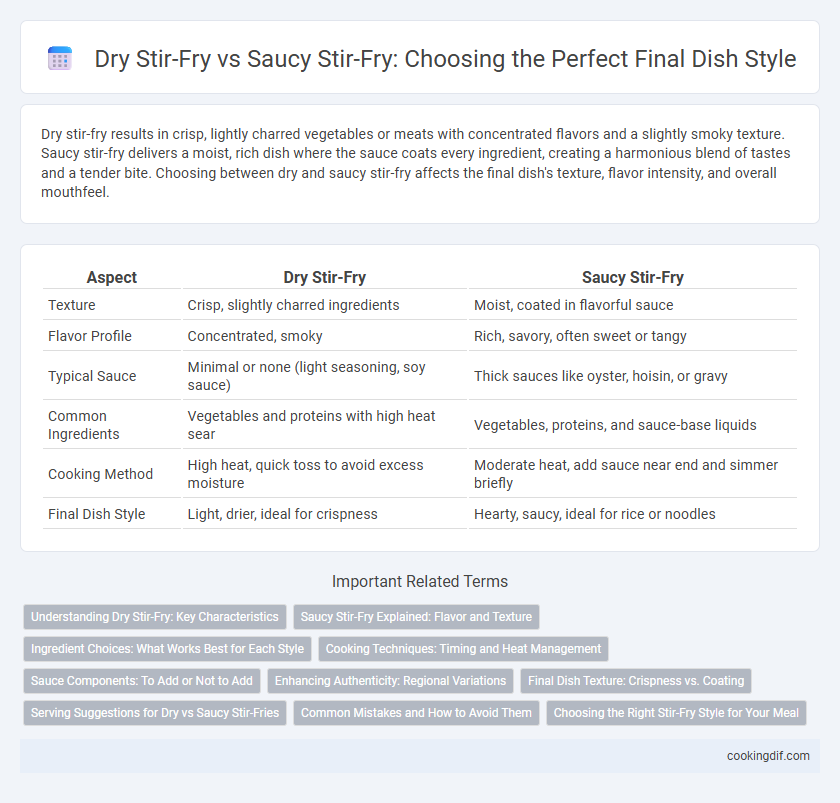Dry stir-fry results in crisp, lightly charred vegetables or meats with concentrated flavors and a slightly smoky texture. Saucy stir-fry delivers a moist, rich dish where the sauce coats every ingredient, creating a harmonious blend of tastes and a tender bite. Choosing between dry and saucy stir-fry affects the final dish's texture, flavor intensity, and overall mouthfeel.
Table of Comparison
| Aspect | Dry Stir-Fry | Saucy Stir-Fry |
|---|---|---|
| Texture | Crisp, slightly charred ingredients | Moist, coated in flavorful sauce |
| Flavor Profile | Concentrated, smoky | Rich, savory, often sweet or tangy |
| Typical Sauce | Minimal or none (light seasoning, soy sauce) | Thick sauces like oyster, hoisin, or gravy |
| Common Ingredients | Vegetables and proteins with high heat sear | Vegetables, proteins, and sauce-base liquids |
| Cooking Method | High heat, quick toss to avoid excess moisture | Moderate heat, add sauce near end and simmer briefly |
| Final Dish Style | Light, drier, ideal for crispness | Hearty, saucy, ideal for rice or noodles |
Understanding Dry Stir-Fry: Key Characteristics
Dry stir-fry is characterized by high-heat cooking with minimal liquid, resulting in crisp, evenly cooked ingredients that retain their natural textures and flavors. This technique emphasizes quick browning and caramelization, producing a dish with a concentrated, intense taste without excess sauce. Mastering dry stir-fry requires precise temperature control and constant stirring to prevent burning while achieving a balanced, savory finish.
Saucy Stir-Fry Explained: Flavor and Texture
Saucy stir-fry features a rich, flavorful sauce that coats each ingredient, enhancing both taste and moisture, creating a tender and juicy bite. Common sauces include soy, oyster, hoisin, and chili-based blends, which provide depth and vibrant umami to vegetables, meats, and noodles. This style balances intense flavors with a glossy, appealing texture, making it ideal for dishes served over rice or noodles.
Ingredient Choices: What Works Best for Each Style
Dry stir-fry favors ingredients with low moisture content such as firm vegetables like bell peppers, broccoli, and snap peas, along with lean proteins like chicken breast or beef strips that sear quickly without releasing excess liquid. Saucy stir-fry thrives on moisture-rich ingredients like mushrooms, zucchini, and tofu, which absorb and complement the thick, flavorful sauces made from soy, oyster sauce, or hoisin. For perfect texture and flavor balance, selecting fresh, crisp vegetables ensures dry stir-fries remain vibrant, while tender, water-retentive ingredients enhance the richness of saucy stir-fries.
Cooking Techniques: Timing and Heat Management
Dry stir-fry requires high heat and precise timing to quickly sear ingredients, preserving their crisp texture and vibrant colors without releasing excess moisture. Saucy stir-fry demands careful heat control and staged ingredient addition to ensure sauce thickens evenly and flavors meld without overcooking the components. Mastering heat management and timing in both methods is crucial for achieving the desired final dish style and optimal texture balance.
Sauce Components: To Add or Not to Add
Dry stir-fry emphasizes high-heat cooking with minimal or no added liquid, resulting in crisp-textured vegetables and concentrated flavors without the dilution of sauce components. Saucy stir-fry incorporates a combination of soy sauce, oyster sauce, hoisin, or broth to create a rich, glazed coating that enhances moisture and umami depth. Deciding to add sauce depends on the desired dish texture and flavor intensity, balancing between preserving ingredient crunch and achieving saucy richness.
Enhancing Authenticity: Regional Variations
Dry stir-fry emphasizes high heat and quick cooking to preserve the crisp texture of ingredients, commonly found in Sichuan and Cantonese cuisines, enhancing authenticity with a focus on natural flavors. Saucy stir-fry, typical of Hunan and Taiwanese styles, relies on thick, flavorful sauces that coat ingredients, adding depth and moisture to the final dish. Both methods reflect regional preferences and cooking techniques that define the unique taste profiles and culinary traditions of Chinese stir-fry dishes.
Final Dish Texture: Crispness vs. Coating
Dry stir-fry techniques emphasize high heat and constant movement to achieve a final dish texture characterized by crispness and a slight char on the ingredients, creating a light and smoky flavor. Saucy stir-fry involves adding a flavorful liquid sauce late in the cooking process, coating each ingredient with a glossy, moist layer that enhances tenderness and delivers concentrated taste. Choosing between dry and saucy stir-fry ultimately defines the dish's texture profile, balancing crispness versus a rich, well-coated finish.
Serving Suggestions for Dry vs Saucy Stir-Fries
Dry stir-fries are ideal for serving over steamed rice or with crunchy side dishes like fresh salads or spring rolls, enhancing their crisp texture and concentrated flavors. Saucy stir-fries pair perfectly with fluffy white rice, noodles, or even steamed buns, allowing the rich, savory sauce to coat each bite evenly. Choose dry stir-fries for a lighter, more textured meal and saucy stir-fries when craving a comforting, flavor-packed dish.
Common Mistakes and How to Avoid Them
Dry stir-fry often suffers from overcooking ingredients, leading to a loss of natural crispness, while saucy stir-fry may become overly thick or bland if sauces are not balanced properly. Common mistakes include using too much oil, overcrowding the pan, and adding sauce too early, which can result in soggy vegetables or uneven cooking. To avoid these issues, use high heat with minimal oil, cook ingredients in small batches, and add sauce gradually towards the end of cooking to preserve texture and flavor.
Choosing the Right Stir-Fry Style for Your Meal
Dry stir-fry emphasizes quick cooking with high heat to maintain crisp textures and vibrant colors, ideal for dishes where the natural flavors of ingredients shine. Saucy stir-fry features a flavorful liquid base, such as soy sauce, oyster sauce, or hoisin, which coats the ingredients and creates a rich, hearty dish perfect for serving over rice or noodles. Selecting between dry or saucy stir-fry styles depends on the desired meal texture and flavor intensity, balancing freshness against sauciness for a satisfying final dish.
dry stir-fry vs saucy stir-fry for final dish style Infographic

 cookingdif.com
cookingdif.com